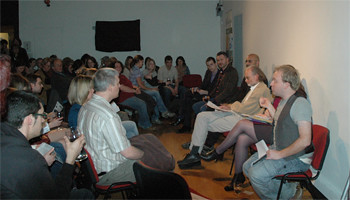The following is an essay written by Dr. Alan Watson and relates to the film Her.
The use of music in films is the secret weapon that producers use to manipulate our emotions and shape our responses to the story. The same footage may appear romantic, sad or even sinister through the choice of music and within these broad confines, more subtle gradations of emotion can also be engendered. A little personal reflection will confirm that a piece of music can change how we feel within seconds, which is quite remarkable for a stimulus which is not found in the natural world. Though we may react emotionally to an ambient sound such as birdsong (perhaps as a consequence of the associations created by early memories) our feelings are unrelated to its real purpose or its meaning to the animal concerned. Furthermore, musical sounds are much richer in structure than natural sounds. The salient parameters include not only melody and rhythm, but also sound quality (timbre), harmony, and key (major versus minor). Despite some exceptions, music that triggers happy or positive emotions is more likely to be in a major key and at a brisk tempo, while melancholic, peaceful or romantic pieces tend to be either slower or in minor keys or both. Music intended to frighten is often discordant with strong or irregular rhythms and large changes of dynamics. Within a given culture, the lexicon of music-associated emotions is largely shared regardless of each individual’s listening preferences, which is something that film producers must rely on if they are to pull off the trick.
Different aspects of music are processed in distinct regions of the brain. Where there is an insistent beat, we feel the urge to tap, nod or even dance in time. These activities require us to predict the beat, for which we must employ internal oscillators or metronomes. The brain does not have any that are dedicated to sound alone, so those that are used to control rhythmic movements (e.g. walking) are pressed into service, hence our compulsion to move. The greater mystery however, is the access that music has to both the mental and physical dimensions of our emotions. It strongly activates the reward system of the brain (which is needed to ensure that we carry out tasks such as eating and reproductive behaviour necessary for our survival) and influences the emotional centres of the limbic system. Our mental responses may be associated with physical ones such as increases in heart rate, changes in blood flow and the prickling sensation of hair rising on the skin. Why it is so effective in doing this is a mystery, as some of the features of music most effective at hijacking this system (e.g. harmony and key) are recent human inventions and can have played no part in shaping the evolution of our brain.
Coming at last to the film, one of the most interesting features of the soundtrack is paradoxically, the use of silence or ambient sounds to accompany the greater part of the story. The music of the introductory sequence is a series of discords, almost a palate cleanser, after which the palpable silence which follows is a relief. The representation of normal life is bland and artificial and the backstory of the human characters is limited and two dimensional. It is only the relationship with the operating system that is given emotional depth and a musical narrative. The OS composes a piece to provide tangible evidence of the relationship with Theodore for which there can be no photographs and one activity that they can share on an equal footing is singing together. Even when there is personal conflict, the music tells us that the breakup does not engender anger or resentment, but only a feeling of loss as the two main characters (one human, one virtual) find themselves inexorably drifting apart. Neither does it allow us to consider that a group of operating systems acting for their own benefit might be sinister or a threatening concept, a question that is perhaps left to be explored in another story!
The use of music in films is the secret weapon that producers use to manipulate our emotions and shape our responses to the story. The same footage may appear romantic, sad or even sinister through the choice of music and within these broad confines, more subtle gradations of emotion can also be engendered. A little personal reflection will confirm that a piece of music can change how we feel within seconds, which is quite remarkable for a stimulus which is not found in the natural world. Though we may react emotionally to an ambient sound such as birdsong (perhaps as a consequence of the associations created by early memories) our feelings are unrelated to its real purpose or its meaning to the animal concerned. Furthermore, musical sounds are much richer in structure than natural sounds. The salient parameters include not only melody and rhythm, but also sound quality (timbre), harmony, and key (major versus minor). Despite some exceptions, music that triggers happy or positive emotions is more likely to be in a major key and at a brisk tempo, while melancholic, peaceful or romantic pieces tend to be either slower or in minor keys or both. Music intended to frighten is often discordant with strong or irregular rhythms and large changes of dynamics. Within a given culture, the lexicon of music-associated emotions is largely shared regardless of each individual’s listening preferences, which is something that film producers must rely on if they are to pull off the trick.
Different aspects of music are processed in distinct regions of the brain. Where there is an insistent beat, we feel the urge to tap, nod or even dance in time. These activities require us to predict the beat, for which we must employ internal oscillators or metronomes. The brain does not have any that are dedicated to sound alone, so those that are used to control rhythmic movements (e.g. walking) are pressed into service, hence our compulsion to move. The greater mystery however, is the access that music has to both the mental and physical dimensions of our emotions. It strongly activates the reward system of the brain (which is needed to ensure that we carry out tasks such as eating and reproductive behaviour necessary for our survival) and influences the emotional centres of the limbic system. Our mental responses may be associated with physical ones such as increases in heart rate, changes in blood flow and the prickling sensation of hair rising on the skin. Why it is so effective in doing this is a mystery, as some of the features of music most effective at hijacking this system (e.g. harmony and key) are recent human inventions and can have played no part in shaping the evolution of our brain.
Coming at last to the film, one of the most interesting features of the soundtrack is paradoxically, the use of silence or ambient sounds to accompany the greater part of the story. The music of the introductory sequence is a series of discords, almost a palate cleanser, after which the palpable silence which follows is a relief. The representation of normal life is bland and artificial and the backstory of the human characters is limited and two dimensional. It is only the relationship with the operating system that is given emotional depth and a musical narrative. The OS composes a piece to provide tangible evidence of the relationship with Theodore for which there can be no photographs and one activity that they can share on an equal footing is singing together. Even when there is personal conflict, the music tells us that the breakup does not engender anger or resentment, but only a feeling of loss as the two main characters (one human, one virtual) find themselves inexorably drifting apart. Neither does it allow us to consider that a group of operating systems acting for their own benefit might be sinister or a threatening concept, a question that is perhaps left to be explored in another story!







No comments:
Post a Comment